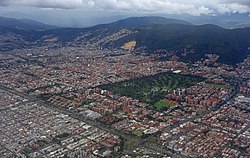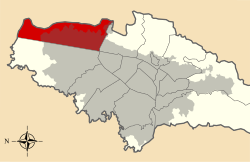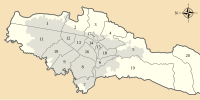|
Usaquén
  Usaquén is the 1st locality of Bogotá, capital of Colombia. It is located in the north of the city. This district is mostly inhabited by upper middle and upper class residents. It is designated as Bogotá's #1 locality, while being a separate municipality of Cundinamarca until 1954, when it was annexed into the city. Today, Usaquén is home to more than 480,000 inhabitants as projected by 2008.[2] The Eastern Hills form the natural border to the east. General informationBorders
Sites of interest
HistoryThe name comes from the cacique Usaque, who was ruling the area of the southern Muisca as part of the Muisca Confederation. Usaque in Muysccubun means "under the pole".[5] In 1537 conquistador Gonzalo Jiménez de Quesada and his troops arrived on the Bogotá savanna. Usaquén was abandoned by Spanish decree in 1777. It was gradually repopulated by people from Bogotá, and was host to some fighting during the war for Colombian independence. It was re-founded as a municipality in 1846, and in 1860 it was the scene of a battle between government troops and Tomás Cipriano de Mosquera. After winning that battle, Cipriano took power of the country. Until 1954, the municipality covered 71 square kilometres (27 sq mi), starting from Avenida España in the south and ending 12 kilometres (7.5 mi) to the north along the road to Chía. It had traditionally been a spot for Bogotá's elites to maintain country homes. When it was integrated into the city, it maintained many of its municipal institutions, but with the supervision of Bogotá's mayor. Under the new constitution of 1991, Bogotá was reorganized into localities. Usaquén was numbered first of twenty. On December 31, 1978, the guerrilla group M-19 took the military base called Cantón Norte, robbing the arsenal. Neighbourhoods and parksNeighborhoodsAmong the important neighborhoods are: Tibabita, Lijacá, Verbenal, San Antonio,El Codito, Servitá, San Cristóbal Norte, Toberín, Barrancas, Cedritos, Bella Suiza, La Carolina, Santa Ana, Santa Bárbara, San Gabriel Norte, Cantón Norte, Francisco Miranda, Las Margaritas, San Patricio and the colonial heart of Usaquén. ParksTorca, located at the extreme north, is the locality's largest park. The Country Club's polo area was acquired by the District and transformed into a metropolitan park for northern Bogotá. Education
Gimnasio Alessandro Volta, a private Italian international school, is in Usaquén.[6] External linksWikivoyage has a travel guide for Usaquén.
References
|
||||||||||||||||||||||||||||||||||




